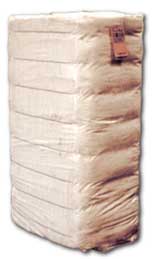
A National Cotton Council analysis affirms that today’s modern cotton production system provides significant benefits to rural America’s economy and environment.
Healthy rural economies are based on stable farm income, and cotton yields and prices are often among the healthiest of all field crops, vegetable or fruit.
Cotton continues to be the basic resource for thousands of useful products manufactured in the U.S. and 
An often-overlooked component of the crop is the vast amount of cottonseed that is produced along with the fiber. Annual cottonseed production is about 6.5 billion tons, of which about two-thirds is fed whole to livestock. The remaining seed is crushed, producing a high-grade salad oil and a high protein meal for livestock, dairy and poultry feed. More than 154 million gallons of cottonseed oil are used for food products ranging from margarine and cooking oils to salad dressing.
The average U.S. crop moving from the field through cotton gins, warehouses, oilseed mills and textile mills to the consumer, accounts for more than $35 billion in products and services. This injection of spending is a vital element in the health of rural economies in the 17 major cotton-producing states from Virginia to California.
The gross dollar value of cotton and its extensive system of production, harvesting and ginning provides countless jobs for mechanics, distributors of farm machinery, consultants, crop processors and people in other support services. Other allied industries such as banking, transportation, warehousing and merchandising also benefit from a viable U.S. cotton production system.

Annual business revenue stimulated by cotton in the U.S. economy exceeds $120 billion, making cotton America’s number one value-added crop.
The farm value of U.S. cotton and cottonseed production is approximately $5 billion.
Overseas sales of U.S. cotton make a significant contribution to the reduction in the U.S. trade deficit. Annual values of U.S. cotton sold overseas have averaged more than $2 billion. Recently, the U.S. has supplied over 10.5 million bales of the world’s cotton exports, accounting for about 37% of the total world export market. The largest customers for U.S. cotton are Asia and Mexico.
Exports of yarn, denim and other U.S.-manufactured cotton products have increased dramatically since the early 1990s, from 1.38 million bale equivalents in 1990, to more than 4 million bale equivalents in 1998.

 Open Menu
Close Menu
Search
Open Menu
Close Menu
Search
-
About
- Leadership Photos of NCC advisors, officers and directors
- Member Benefits Strong industry member participation helps the National Cotton Council represent U.S. cotton on numerous issues and keep it competitive
- Member Web Sites Connect with the cotton community via websites of multiple NCC member firms
- Related Organizations Descriptions of and links to various organizations that serve the U.S. cotton industry
- Report to Members National Cotton Council action on behalf of the U.S. cotton industry is described in annual reports
- Structure The National Cotton Council is a federation that works out common problems and develops programs of mutual benefit for its members.
-
Economics
- Crop Info An abundance of information such as a profile of U.S. cotton’s economic contributions and updated U.S. cotton acreage, production and export numbers
- Government Programs Facts on the federal farm law including details on crop insurance and conservation programs
- Prices Key price data and marketing loan program values.
- Reports & Publications The National Cotton Council’s Weekly Cotton Market Report, its annual Economic Outlook and more
- Textiles Statistics on U.S. cotton textile imports and exports data and a textile trade policy summary
- Weather & Exchanges Links to weather websites and to exchange/market websites
-
Education
- Available Educational Resources National Cotton Council educational materials available for download offer useful teaching aids/guides to help students learn more about one of the world's major agricultural commodities
- Cotton: From Field to Fabric Describes the major steps involved in producing and processing cotton
- The Story of Cotton Tells the story of cotton -- where and how it's grown, processed and woven into cloth -- in simple terms
- U.S. Production Map This map shows the most recent U.S. cotton production by county
- Frequently Asked Questions Answers about the U.S. cotton industry and the National Cotton Council
-
Issues
- Find Your Congressional Contacts Contact information, including a list of staffers, of House and Senate Members in Cotton Belt states
- Government Web Sites Links to key USDA agencies and services and to other government websites
- Agri-Business Database of agribusiness firms who have a stake in a healthy U.S. cotton industry
- CAC Committee for the Advancement of Cotton
- NCC Membership Benefits by State State-by-state benefits for NCC Members
-
Technical
- Bale Packaging Bale packaging, specifications, standards, permanent identification
- Biotechnology Reports, studies, links to other resources
- Contamination-Free Cotton Round Module Wrap Standards, Prevention Video, Guidelines, Resources
- Cottonseed Products, research, general information
- Flow-Shipment Improvement initiatives, warehouse reporting, shipping standards
- Pest Management Boll weevils, nematodes, seedling diseases, cotton pest loss data
- Physiology Best management practices, Cotton Physiology Today newsletters archives, water use
- Pollinator Protection State-managed plans (MP3s)
- Quality Preservation Guidelines, Module Averaging, Bale Moisture
- Safety & Security OSHA, oil spill prevention, fire/building codes, hazardous material rules
- Sustainability U.S. Cotton's Sustainability
- Beltwide Cotton Conferences January 7-9, 2026 San Antonio Marriott Rivercenter, San Antonio, Texas
-
News & Events
- Audio & Video Broadcasters can download interviews with National Cotton Council leaders/staff, Congressional Members and government officials.
- Cotton's Calendar Dates and places of key meetings of the National Cotton Council, various NCC member firms and cotton interest organizations
- Cotton's Week Archives of the National Cotton Council's premier member newsletter
- Meetings Links to information from National Cotton Council annual meetings and other key NCC forums
- News Releases Current and archived National Cotton Council news releases
- Beltwide Cotton Conferences January 7-9, 2026 San Antonio Marriott Rivercenter, San Antonio, Texas
- Log in
- Preferences
- NCC Intranet
- NCC Admin